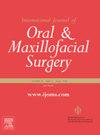Accuracy of patient-specific implants versus CAD/CAM splints with the mandible-first approach in bimaxillary orthognathic surgery for skeletal Class II malocclusion
IF 2.2
3区 医学
Q2 DENTISTRY, ORAL SURGERY & MEDICINE
International journal of oral and maxillofacial surgery
Pub Date : 2025-02-01
DOI:10.1016/j.ijom.2024.05.005
引用次数: 0
Abstract
This retrospective study aimed to compare the accuracy of patient-specific implants (PSI) versus mandible-first computer-aided design and manufacturing (CAD/CAM) splints for maxilla repositioning in orthognathic surgery of skeletal Class II malocclusion patients. The main predictor was the surgical method (PSI vs. splints), with the primary outcome being the discrepancy in maxilla centroid position, and secondary outcomes being translation and orientation discrepancies. A total of 82 patients were enrolled (70 female, 12 male; mean age 25.5 years), 41 in each group. The PSI group exhibited a median maxillary position discrepancy of 1.25 mm (interquartile range (IQR) 1.03 mm), significantly lower than the splint group's 1.98 mm (IQR 1.64 mm) (P < 0.001). In the PSI group, the largest median translation discrepancy was 0.74 mm (IQR 1.17 mm) in the anteroposterior direction, while the largest orientation discrepancy was 1.83° (IQR 1.63°) in pitch. In the splint group, the largest median translation discrepancy was 1.14 mm (IQR 1.37 mm) in the anteroposterior direction, while the largest orientation discrepancy was 3.03° (IQR 2.11°) in pitch. In conclusion, among patients with skeletal Class II malocclusion, the application of PSI in orthognathic surgery yielded increased precision in maxillary positioning compared to mandible-first CAD/CAM splints.
在双颌正颌手术治疗骨骼类 II 型错颌畸形时,采用下颌先入法的患者特异性种植体与 CAD/CAM 夹板的准确性对比。
这项回顾性研究旨在比较患者特异性种植体(PSI)与下颌骨先行计算机辅助设计和制造(CAD/CAM)夹板在骨骼Ⅱ类错颌畸形患者正颌手术中上颌骨复位的准确性。主要预测因素是手术方法(PSI 与夹板),主要结果是上颌骨中心点位置差异,次要结果是平移和方向差异。共有82名患者(70名女性,12名男性;平均年龄25.5岁)参加了此次研究,每组41人。PSI 组的上颌位置差异中位数为 1.25 毫米(四分位间距 1.03 毫米),明显低于夹板组的 1.98 毫米(四分位间距 1.64 毫米)(P<0.05)。
本文章由计算机程序翻译,如有差异,请以英文原文为准。
求助全文
约1分钟内获得全文
求助全文
来源期刊
CiteScore
5.10
自引率
4.20%
发文量
318
审稿时长
78 days
期刊介绍:
The International Journal of Oral & Maxillofacial Surgery is one of the leading journals in oral and maxillofacial surgery in the world. The Journal publishes papers of the highest scientific merit and widest possible scope on work in oral and maxillofacial surgery and supporting specialties.
The Journal is divided into sections, ensuring every aspect of oral and maxillofacial surgery is covered fully through a range of invited review articles, leading clinical and research articles, technical notes, abstracts, case reports and others. The sections include:
• Congenital and craniofacial deformities
• Orthognathic Surgery/Aesthetic facial surgery
• Trauma
• TMJ disorders
• Head and neck oncology
• Reconstructive surgery
• Implantology/Dentoalveolar surgery
• Clinical Pathology
• Oral Medicine
• Research and emerging technologies.

 求助内容:
求助内容: 应助结果提醒方式:
应助结果提醒方式:


